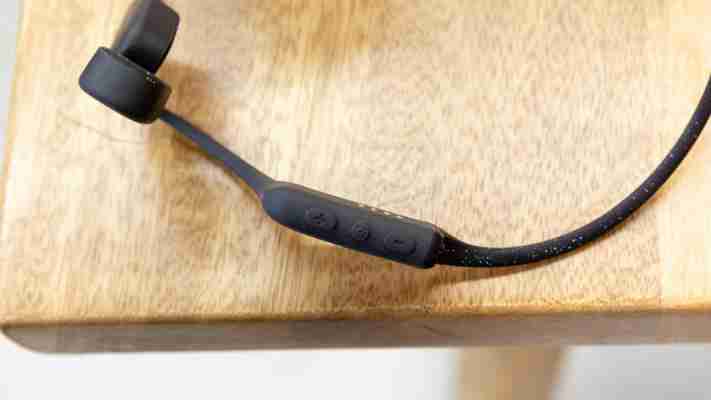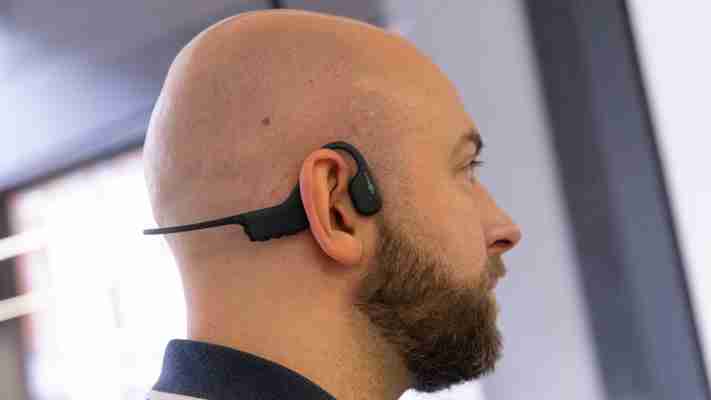Waterproof MP3 players and headphones have been around for a while but it’s not all that often you see a pair utilising bone conduction technology as their method of audio delivery. AfterShokz has been pioneering this tech since 2011 and its Xtrainerz implement it superbly for those wanting to liven up their aquatic training regime.
What is bone conduction?
Traditional headphones use speakers to generate sound, emitting sound waves that pass through the ear canal and eardrum on their way to the inner ear. In contrast, bone conduction headphones create mini vibrations that move through bones in your skull – typically the cheekbones – and into the inner ear. Sound pressure impulses are then converted into electrical impulses which are transmitted to the brain via the auditory nerve, allowing the user to hear whatever is being broadcast.
What are the benefits of bone conduction headphones?
Bone conduction headphones have a number of benefits, both practical and health-related. As the ear canal is not blocked, you remain able to take in noise from your surroundings, which is useful for musicians and sportspeople but also has value in busy urban environments. Another advantage of not having one’s ear canals blocked is a reduction in the likelihood of infections caused by dirt, bacteria and excess earwax.
Freeing up your ear canals is great if you’re in the open air but if you’re swimming hundreds of laps a week, chances are you’ll be wanting to keep water out of your ears. Bone conduction headphones allow you to pop in earplugs, while still being able to enjoy your chosen audio.
READ NEXT: Best running headphones
What do you get for the money?
For £140 you’re getting a pair of IP68-rated bone conduction headphones, with that rating guaranteeing them protection from immersion in water up to 2m deep for two hours. There’s no Bluetooth connection; these are purely MP3 headphones with support for WMA, AAC, WAV and FLAC audio file formats.
The Xtrainerz have 4GB storage, which AfterShokz says equates to roughly 1,200 songs. I put 28 hours of audio onto them – a mixture of audiobooks and music tracks – and still had 3GB to spare, so you’re never going to be short on listening options. You’re not short on battery life either, with the battery providing up to eight hours of play time, an hour more than it took Bulgarian Petar Stoychev to swim the English Channel in 2007.
Included with the Xtrainerz are a USB charging cradle, which is used to transfer music, a pair of triple-flange swimming earplugs and a carrying case. The case is good quality, with holes to drain excess water, and the earplugs did their job very efficiently.

How easy are they to control?
The Xtrainerz’ control centre is located behind the right ear loop, allowing easy access to the four buttons that control power, modes, volume and track selection. Most controls involve a single press, although there are a few features that require holding down a button or pressing buttons simultaneously, such as switching between folders or changing the language the AI “Audrey” speaks to you in. Overall, after a quick read of the manual, you’ll have memorised the controls and it all becomes very intuitive.
How do they sound?
Bone conduction headphones are not renowned for their sound quality but I was impressed by the Xtrainerz both in and out of the water. They utilise PremiumPitch 2.0+ technology, which promises higher volume, more bass and less vibration compared to previous iterations of the tech and it delivered on all counts.
There are two EQ profiles available – General and Underwater – with the latter accentuating mids and highs for vocal clarity when you’re submerged. You’re not getting audiophile levels of sound quality but audiobooks and music both sounded great. The included earplugs serve a dual purpose, preventing water from getting in your ears and helping shut out external noise, which makes for an improved listening experience. When using the Xtrainerz out of the water there was a fair bit of sound leakage, so they don’t double up very well as commuting headphones but that’s not a surprise given they’re specifically designed for swimming.

What’s the fit like?
It took a little while getting used to how the Xtrainerz felt on my head but once I became accustomed to them, it was almost like they weren’t there. They are super light (just 30g) and are made from flexible titanium meaning they should fit any head comfortably. I wondered how well they would remain attached to my head when underwater but this wasn’t an issue, even when plunging forcefully below the surface. I don’t typically wear a swimming cap – one of the benefits of being bald – but did for periods during testing. Getting it on over the Xtrainerz while still being able to access the headphone’s controls was cumbersome at first but became easier with practice. Once everything is in position, you don't have to worry about the headphones becoming dislodged so it's just a matter of ensuring you take the time to position them properly before embarking on your swim.
Should you buy them?
If you’re looking for a wonderful way of listening to audio while training in the pool or open water, I’d whole-heartedly recommend the AfterShokz Xtrainerz. Battery life, storage space, comfort and sound quality are all great and bone conduction allows you to wear earplugs, too, which is a big plus. They may be rather pricey, but if you’re borderline amphibious, they’re well worth it.
If you're after a pair of bone conduction headphones for use outside of the pool, then you'll want to check out the AfterShokz Aeropex , which feature on our list of the best headphones . The Aeropex are almost identical in design to the Xtrainerz but are Bluetooth-enabled to allow you to stream music from your phone while running and feature a noise-cancelling microphone for making and receiving calls.